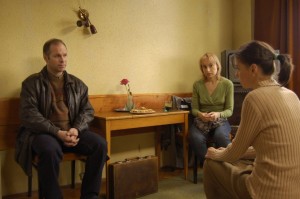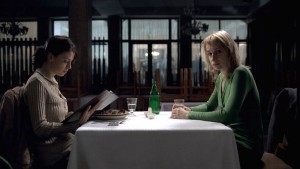 Because this film is not agenda-heavy or preachy, it allows us to see a simple story, based apparently on a true story. We see the dangers of illegal abortion and the ways in which women can easily be taken advantage of in such a situation. We meet a monster, one moment empathetic and knowledgeable and the next moment preying on women in a time of weakness, the abortionist named Bebe. He forces the women to trade sex for Gabita’s abortion, a unimaginable horror at an already emotionally charged moment.
Because this film is not agenda-heavy or preachy, it allows us to see a simple story, based apparently on a true story. We see the dangers of illegal abortion and the ways in which women can easily be taken advantage of in such a situation. We meet a monster, one moment empathetic and knowledgeable and the next moment preying on women in a time of weakness, the abortionist named Bebe. He forces the women to trade sex for Gabita’s abortion, a unimaginable horror at an already emotionally charged moment.
(As an aside, I wish every film dealing with sexual exploitation managed to handle it as appropriately as this one does. The horror of what happens is clear, but is not shown, although some non-sexual nudity is shown. Instead, we see the impact of the exploitation. Nobody gets to get turned on by abuse in this film. It’s not sexy; it’s ugly and traumatizing. The silence and trepidation is more powerful than showing us one more scene of women getting abused. We see the women scrubbing themselves clean of the horror afterwards, rinsing their mouths out. We see their emotional disquiet. In many films and television shows that deal with this evil, there is a risk of exploitative portrayal of the very exploitation that is being condemned. Instead, this film humanizes the victim and shows the horror of the impact.)
And yet, the film in its stark realism also doesn’t squirm away from what abortion actually is–the taking of a life. There is a moment after the abortion has taken place when Otila, who has been charged with disposing of the dead fetus, sees it for the first time. For a long pause, the camera lingers on her and then Gabita staring at the body. Finally, then the camera turns to the fetus and we see it too, looking for all the world like a real developing baby.
This film certainly shows us the unfair pressure put on women in Communist Romania. Even the “good guys” who try to understand the plight of a woman fall short of doing so (as we see in the scenes with Otila’s boyfriend). When he refuses to hear that she needs to attend to something else important the night of his mother’s birthday party and requires her to attend as a precondition to his love, and when she shows up at the party exhausted and drained from having to sell her body in exchange for her friend’s abortion, deeply terrified for the health and safety of her friend post-abortion, and traumatized by it all, he and the family just seem to want her to make merry. The burden the women are asked to bear for society is juxtaposed with the merriment of the gathered guests in a brilliant long single shot, framing Otila and her boyfriend crammed at the end of the table, while family goes on and on about superficial matters, clueless to Otila’s private misery.
But this film also shows us what abortion really is. The seemingly flippant way in which Gabita approaches the abortion is tempered a bit when she actually sees the fetus. Though the abortionist has counseled both women to discard the fetus in a garbage shoot at the top of a building, Gabita, having seen the fetus begs Otila to bury it (a request too dangerous to fulfill). The long focus on the two women’s reaction to seeing the body of the fetus also gives us a sense of the sacredness of the discarded life. Though they might not make another decision given the option, we are not allowed to sequester the result of an abortion as just the removal of some tissue. There is something real here, an actual life.
 In the closing scene, the women go down to dinner at the hotel where they are staying and are served the menu of a wedding which is taking place at the hotel: beef, liver, kidneys, breaded brains. The women seem understandably nauseated by this mass of embodied tissue, so reminiscent of the life they just discarded. But the film does not preach this to us. It is subtle and neither pro-choice nor pro-life. It is lived experience. Much like Abortion Diaries.
In the closing scene, the women go down to dinner at the hotel where they are staying and are served the menu of a wedding which is taking place at the hotel: beef, liver, kidneys, breaded brains. The women seem understandably nauseated by this mass of embodied tissue, so reminiscent of the life they just discarded. But the film does not preach this to us. It is subtle and neither pro-choice nor pro-life. It is lived experience. Much like Abortion Diaries.
In the end, 4 Months humanizes all involved in this story. We need more of that. More humanity, more empathy, more listening to stories.
——————-
Community discussion guidelines:
Because this is a Christian blog, the things I’m talking about will obviously be topics that people feel strongly about in one direction or another. Please keep in mind that this is a place for substantive, respectful, constructive conversation. All perspectives are welcome to discuss here as long as all can treat each other with kindness and respect. Please ignore trolls, refuse to engage in personal attacks, try not to derail the conversation into divisive rabbit trails, and observe the comment policy listed on the right side of the page. Comments that violate these guidelines may be deleted. Vulgar remarks may result in immediate blacklisting. For those who clearly violate these policies repeatedly, my policy is to issue a warning which, if not regarded, may lead to blacklisting. This is not about censorship, but about creating a healthy, respectful environment for discussion.
P.S. Please also note that I am not a scientist, but a person with expertise in theology and the arts. While I am very interested in the relationship between science and faith, I do not believe I personally will be able to adequately address the many questions that inevitably come up related to science and religion. I encourage you to seek out the writings of theistic or Christian scientists to help with those discussions.
———————-
Photo credits (all from IMDB.com):
Anamaria Marinca and Laura Vasiliu in 4 Months, 3 Weeks and 2 Days (2007)
4 Months, 3 Weeks and 2 Days (2007)
Anamaria Marinca and Laura Vasiliu in 4 Months, 3 Weeks and 2 Days (2007)












